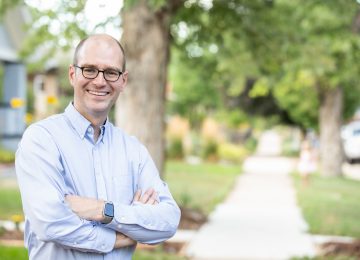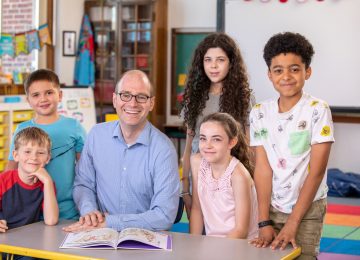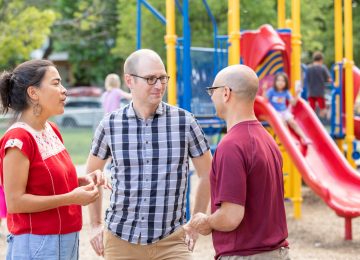Frequently Asked Questions

Why Are You Running?
We need leaders who will truly listen to the community. I am someone engaged with and serving alongside the community every…

What about Charters and Choice?
DPS is capable of offering a quality education to every child, in every school, and must accept the responsibility of doing…

How Do We Make Our Schools Safe?
School safety begins with better care and attention for every student, especially mental health care…
Policies and Ideas: More Conversations and Details
Our schools are more segregated than they have been in generations. This brokenness is the result of district decisions and larger hegemonic systems, and both must be addressed.
Choice was meant to be a way for families to have a variety of styles and methods of education, chosen from a collection of quality options in their own neighborhood. Instead, choice has become a method for families, with the capacity and resources, to search for perceived quality that has been denied neighborhoods- most often neighborhoods with higher percentages of people of color or lower socio-economic status, and this problem is exaggerated by a broken SPF. We must reinvest in schools and neighborhoods that serve our lower socioeconomic status students and our students of color by providing more opportunities, enrichments, and extracurricular activities, funded by the district and not by PTAs, and supporting the retention of high quality educators and staff.
DPS must also acknowledge and respond to the increased geographic segregation across Denver. Neighborhood schools become more segregated when neighborhoods gentrify. This is a complicated problem with no easy answers, but the conversations must happen. Schools that were in desperate needs before their neighborhood gentrified, that are now thriving, are an affront to communities of color and should be an indictment of the racism of our system. Responding to these failures and developing solutions must be done in dialogue with our community. People of color and lower socioeconomic status must have a seat at the table and be worked with, not just talked about.
Increased transparency and accountability in district finances are foundational to equitable funding. There are schools that do not receive monies they are eligible for because they have not been made aware they qualify for it. Grant programs are instituted without long term plans to continue important programs that communities connect with and rely on. Equitable funding will also require proactive efforts to listen to the concerns of community and provide in depth information and synthesis of the data behind our decisions and realities. Simply releasing an obfuscated line item budget is not transparency.
We must return to the guiding question- “how does this benefit our students?”. Institutions like to preserve themselves, and the burgeoning bureaucracy of DPS exemplifies this; no district in Colorado spends less in their classrooms (only 48% makes it to the classroom).
Increasing staff of all kinds, in our classrooms and neighborhood schools, will tend to many of our district’s largest issues: the achievement gap, reading levels, mental health and school safety, all of them can be addressed by better resourcing and lowering the student to adult ratios. We must also set our teachers up for success by providing curriculum and resources that do more than prepare a child for a test. Changing our test focused culture will bring more student focused resources to the classroom. Increased resources in classrooms must also be grounded in equity, which means some classrooms will get more than others to fully meet the needs of students and schools who have less to begin with.
We need to move to less testing with fewer institutional decisions based on the results. Student progress is best measured by the teachers who know each student, with testing based on the context of each classroom and student, as seen in periodic formative assessments. Teacher accountability is better accomplished through observation and coaching.
Standardized tests can only tell you something about a student, at a given point in time, they do not tell you about a teacher. What they often tell us about students is that the test was not written for a particular student. Our current testing models also shape what curriculum we are able to use, curriculum that is not designed for the diversity of our student population. Standardized testing also minimizes our ability to focus on educating the whole person, as social, emotional, and resiliency are not measured in multiple choice or short answer.
The changes necessary must start by reshaping how we use the results of the tests. The decisions and policies based on the results of standardized testing shape a great deal. Policies within board control require revision in this area. The outside factors shaping the role of testing, particularly state and federal laws, must be addressed through advocacy and communication. Our board members must be active in their work with the state board, state legislators, and representatives in Washington, D.C. Our board must also educate and prepare our students’ families to be engaged in the necessary legislative changes.
Every student deserves an education that engages all of who they are, that builds upon the world they know, that reflects the diversity of their community in history and current events, and that lets them see themselves in the education process. Culturally affirming education requires culturally responsive curriculum, more diversity in our teachers, and learning environments that reflect the communities they serve.
Work has begun in DPS to develop culturally responsive curriculum. This work must be prioritized and expanded. Community members must have a strong voice in the process- we must quit talking ‘about’ people and begin working with them. We must also look at the enrichments and extracurricular activities we offer and ensure they also reflect the diversity of students we serve.
Our schools provide the best education for every child when our teachers, staff, and leadership reflect the full breadth of humanity that is present in our community. The unique perspectives and life experiences educators of color bring by being who they are must be sought with extra intention. Active recruitment through partnerships with higher education to pursue those about to enter the field followed by the mentoring of new teachers is essential. But we can only recruit from higher education those who have been encouraged and supported on their way there. The early identification of the gifts and calling that make a great educator with the students we currently serve is also a foundational step. We need to nurture them on their way to becoming teachers and intentionally recruit them back, as having educators of color who have been educated in our school system brings strength and wisdom.
Our physical spaces must also change. On a recent tour of schools across the district, it was notable how many of our schools lack photos and inspiring quotes from historical figures of color. The murals and hanging art do not reflect the cultural diversity of the full breadth of communities we serve. A group of student leaders I spoke with noted the lack of cafeteria menu choices that reflect their tables at home. Decades of choices, that shape the everyday experiences of our students of color, were made by majority white leaders who have left incredible bias and systemic racism in their wake, which we must acknowledge and address.
The national culture of fear inflicted on immigrants (documented or not) and refugees requires partnership as allies and advocacy from individuals and systems. We see the negative impacts on our students through their ability to focus, the ability of their entire families to participate in activities and classroom engagement, as well as in attendance. DPS must do everything in its power to care for our immigrant and refugee families.
We must follow through on the commitment that no data in our systems will ever be shared with ICE. And we may need to find alternative and more relational methods of keeping data for those who still feel apprehension regardless of our commitments. We must be explicit and public in our resolve that every student and their family will be guarded from arrest on or around our properties. This may at times also require creativity and flexibility in the timing and location of drop-off and pick-up. It is not enough to guard our students from a system that seeks to tear families apart, we must also care for the emotional trauma and anxiety our students and their families are experiencing through the work of expanded mental health services and staffing.
Our curriculum must be intentional in teaching students about the U.S.’s history of immigration. We must celebrate that when our country has welcomed people, our society has seen growth and prosperity. We must also name our many failures and the history of oppression and white supremacy in our laws and in our streets. Every student should be educated on the rights of all people, including the specific rights of immigrant persons during ICE raids. Intentional inclusion of such history, current events, and civic rights fulfills our commitment to a full education while also building allies.
The language in our DPS curriculum and classrooms must honor the full breadth of gender identity and expression. Our schools should not systematically add to the rampant heterosexim and cis-genderism in the daily lives of our LGBTQ+ students. Our schools are a place to confront micro-aggressions and patterns of exclusive language as we not only learn history, but engage the current realities of our society. How our schools, staff, and curriculum talk about people has potential to educate and model for students and their families what a supportive and equitable community looks like.
Our physical space also demonstrates our values- any student who would like, should have access to a gender neutral bathroom.
I am grateful for the state legislature’s work to expand the quality and inclusivity of information in our sexual health education; such legislative work is a framework from which we have the opportunity to build. As a former community health educator at the University of Colorado, I believe in, and have taught, comprehensive and inclusive sexual health education that is clear about risk factors for all sexual activities. This benefits all students, and the wellbeing of our entire community, not only LGBTQ+ students.
DPS must do a better job of making contextual decisions for our schools- decisions based on the specific realities of each school and its students, each neighborhood and its community. Efforts to intervene often address symptoms of deeper issues, but do not tackle the harder work that is leading to systemic failure. Closing schools does not solve the problem of communities not being properly served. We must listen to the community who attend the school, the community that has chosen not to attend the school, and the staff that have not remained in order to fully assess what is occurring in a school and its neighborhood. We must listen for themes that can generate real change and then provide the resources necessary. Our understanding of performance must also be expanded beyond our current SPF. There are schools that are not serving students well that, due to failures in the SPF, appear to be succeeding. These schools need work and attention before their shortcomings grow beyond the SPFs inability to identify them. We also have schools that have made great strides in serving their students, that due to failures in the SPF, continue to be told they are failing. Such labeling causes the attrition of quality leadership and damages the self concept of our students and the staff who serve them.
We must develop a long term strategy for providing every school with the means to regulate their temperature in an increasingly warming climate. This strategy must address immediate needs, that are beyond our financial capacity, with simple and creative solutions. Putting A/C immediately in every classroom is costly ($220 million) and unreasonable.
DPS should invest putting A/C in existing schools where possible and efficient. There are also cheaper and more effective ways of cooling classrooms. DPS should be investing in creative solutions to this problem, like heat exchange fan systems.
Another option is a September start. There are minimal monetary impacts to such a move. On average, the last two weeks of August are 8% hotter than the first two weeks of June. By pushing the start and end dates of the school year forward just two weeks, we would be looking at a much easier solutions to cooling schools.
As a former community health educator, I recognize the importance of age appropriate comprehensive health education curriculum and support its place in our classrooms. The crux of such education is age appropriate roll out.
Our youngest students are safer and less likely to be victims of child assault when they know the proper names of their body parts and must learn concepts such as their right to be “Safe, Strong, and Free”. Our oldest students must be informed of the risk factors of sexual activities. There is a long continuum between these two components that includes everything from basic biology to self-determination and consent.
Community input on comprehensive health education must be regularly solicited and considered by the education and health experts who shape our curriculum.
All education is value based, as education is a value in and of itself. There is a benefit to our students and community when we are intentional about whole-child education, including social-emotional education. Many broadly recognized values, such as those identified by DPS at a district level, can be expressed in a variety of words and names. Selecting the specific values of a school can be a community building exercise and contribute to a healthy school culture. For example, my son’s school practices WoRLD CARE: Wonder, Responsibility, Leadership, Determination, Compassion, Advocacy, Respect, and Empathy. These values shape every interaction between students, staff, and families.
Our curriculum and educational environment must be responsive to the community and cultures present. There is great diversity present in Denver that brings with it a plethora of ideas and life experiences that need to be honored. Conversations about values must recognize that there are often differing sets of values present in our community. In such situations, a value of inclusivity can be demonstrated by naming and creating space for the differing values as a form of education.
